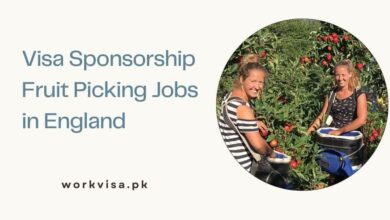Visa Sponsorship Fruit Picker Jobs in Canada 2025 – Apply Now

Canada has entered the agricultural market, particularly in the fruit picking sector, due to the continuing high demand for processed fruits and vegetables worldwide. In addition to the fundamentals, this industry provides individuals with the opportunity to acquire a variety of products.
Local and international employees are additionally provided with numerous employment opportunities. If you are in quest of a new job in Canada, you may be interested in the fruit picker jobs that offer visa sponsorship.
Check Also: Health Care Sector Jobs in Canada – Apply Now
Key Points:
- Title of Position: Fruit Picker
- Location: A variety of locations throughout Canada
- Occupation: Seasonal
- Visa sponsorship is accessible.
Requirements:
- Age: The intended applicants must satisfy specific criteria, one of which is that they must be at least 18 years of age.
- Physical Fitness: The work’s physical nature necessitates a high level of strength to endure the lengthy hours spent glazing castles and towers, as well as performing repetitive motions throughout the day.
- Experience: While agricultural experience is advantageous, numerous employers provide on-the-job training.
- Language Proficiency: The candidate must possess a fundamental understanding of the English or French language in order to effectively communicate with the local populace.
- Work Permit: A legal work permit is typically required. Therefore, Visa sponsorship normally includes assistance with the acquisition of this permit.
Benefits of Job:
- Competitive Earnings: Fruit pickers often earn based on the volume of produce harvested or an hourly wage, which can be competitive. Hardworking individuals can maximize their income by increasing productivity.
- Availability of Seasonal Work: Fruit picking jobs are seasonal, typically aligned with harvest periods. This allows workers to plan for temporary employment during specific times of the year, ideal for students, travelers, or those seeking short-term work.
- No Formal Education or Experience Required: Most fruit-picking jobs don’t require prior experience or formal qualifications, making them accessible to a wide range of people, including first-time job seekers.
- Opportunity for International Workers: Through Canada’s Seasonal Agricultural Worker Program (SAWP) or similar initiatives, individuals from various countries can secure work permits and gain international work experience.
- Free or Subsidized Accommodation: Many employers provide free or low-cost housing for workers on or near the farm, reducing living expenses and offering convenient access to the job site.
- Physical Activity: Fruit picking involves physical labor, which can help workers stay active and fit, particularly for those who enjoy working outdoors.
- Exposure to Canada’s Natural Beauty: Fruit picking jobs are often in scenic rural or semi-rural areas, providing workers the chance to experience Canada’s beautiful landscapes, such as orchards, vineyards, and rolling countryside.
- Cultural Exchange: For international workers, fruit picking offers a chance to learn about Canadian culture, improve English or French language skills, and interact with people from diverse backgrounds.
- Pathway to Permanent Residency: Some agricultural workers can transition to permanent residency in Canada through immigration programs like the Agri-Food Pilot or Provincial Nominee Programs (PNPs).
- Flexible Work Environment: Many fruit-picking jobs offer flexible hours, enabling workers to balance other commitments or take breaks as needed.
Duties For Visa Sponsorship Fruit Picker Jobs in Canada:
- Harvesting: The appropriate harvesting of specific crops, such as apples, berries, cherries, and grapes, which should be done delicately to prevent bruising.
- Harvesting: The process of harvesting entails the sorting and grading of fruits based on their size, quality, and ripeness, either by picking all the fruits in a tree at once or as they ripen.
- Packing: Locating containers or boxes to accommodate the sorted fruits during transportation.
- Maintenance: Inadequate work organization, unhygienic placement of critical equipment, and an unsanitary work environment.
- Monitoring: Conducting a survey of crops to detect any evidence of pests or diseases.
- Documentation: Records of the working hours of each vehicle and the quantities of culled fruit produced were also maintained.
Salary:
The salary for laborers who pick fruits in Canada depends on the fruit, location, or with whom the fruit picker is working. Regarding compensation, the average hourly wage will vary from CAD 14 to CAD 20 depending on the country. Additional methods of optimizing the compensation structure include lump sum payments for performance incentives, additional working hours’ allowance, expatriate living allowances, and meal allowances.
Types of Fruit Picker Jobs in Canada:
- Berry Picker: This activity is primarily conducted during the summer, when individuals engage in the collection of a variety of berries, such as raspberries, blueberries, and strawberries.
- Cherry Picker: The process of selecting cherries is delicate, necessitating extreme caution to prevent the fruit from being bruised.
- Grape Picker: The act of collecting grapes from vineyards for the purpose of either utilizing them in the winemaking process or consuming them as raw fruit.
- Pear Picker: The process is similar to that of selecting apples, but the methods used are distinct due to the fact that kiwis are much more delicate and softer than apples.
- Peach Picker: the process of harvesting necessitates a high degree of care, craftsmanship, and delicacy when selecting or collecting fruits such as peaches.
- Plum Picker: The activity of harvesting plums, with a preference for the conclusion of the summer.
- Citrus Pickers: Cold climates are primarily associated with the harvesting of citrus fruits, such as oranges and lemons, as well as any other citrus fruits that originate from tropical regions.
- Tomato Picker: The process of harvesting tomatoes, which may take place in greenhouses or open fields, is contingent upon the weather.
- Melon Picker: The act of transporting fruits such as melons, watermelons, and cantaloupes necessitates a certain degree of muscle due to their bulkiness.
Application Proces:
- Research: Begin by conducting preliminary searches of Canadian farms and agricultural companies that offer fruit-picking employment with visas. Job Bank Canada, Indeed, and other agricultural recruitment agencies are among the most effective sources.
- Document Preparation: A resume, passport, document verifying work experience, and pertinent certifications, if available, should be prepared at a minimum.
- register Online: You have the option to search and register through a variety of websites and agencies, such as Career Builder and Mom Competition. Ensure that the sections of the application that pertain to your personal profile include information regarding your physical fitness, preparedness to work outdoors, and (if applicable) prior experience.Submit your application immediately.
For More Info:
Email Your CV, and We’ll Find the Best Pathway For you: info@workvisa.pk
Frequently Asked Questions:
-
What is the skill of a fruit picker?
Manual Dexterity: Possess a steady hand and a strong sense of coordination. Fruit identification: the ability to recognize the type, maturity, and condition of the fruit. Climbing: skill in scaling trees and ladders to reach higher branchesHeavy Lifting: This skill involves the ability to lift, carry, and transport heavy objects.
-
How much is a fruit picker’s salary in Canada?
The average hourly pay for a fruit picker in Alberta is $14.15 an hour. While ZipRecruiter is seeing salaries as high as $20.91 and as low as $7.69, the majority of fruit picker salaries currently range between $11.54 (25th percentile) and $15.62 (75th percentile) in Alberta.
-
How to make a Canadian resume for fruit pickers?
Every fruit picker resume should have at least five sections: contact information, professional summary, work experience, skills, and education. It can also be helpful to add extra sections if they show you’re a fit for the job. Ensure you only share relevant qualifications in your resume’s additional sections.




